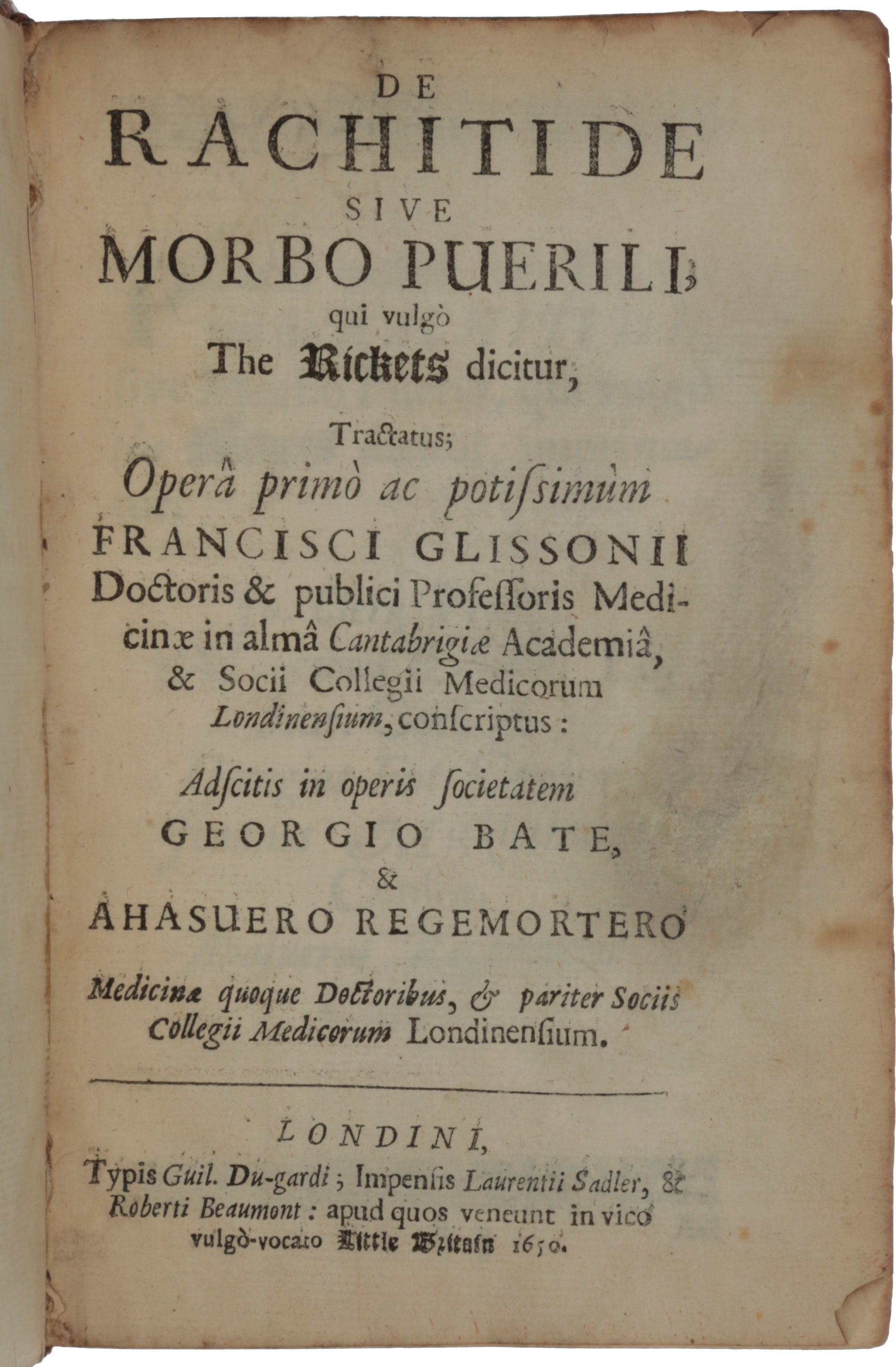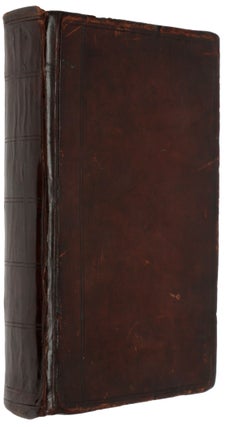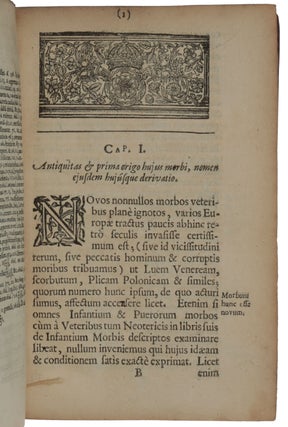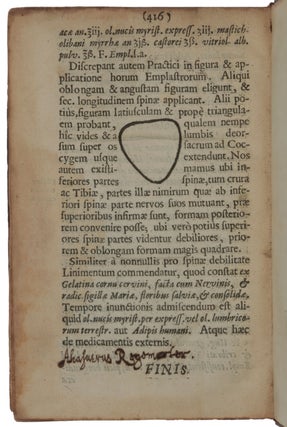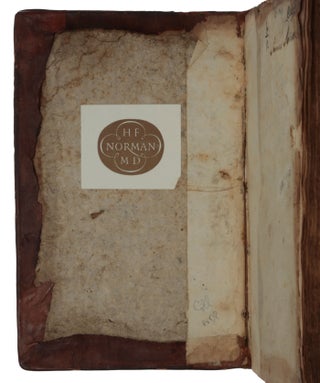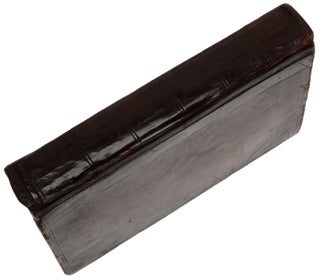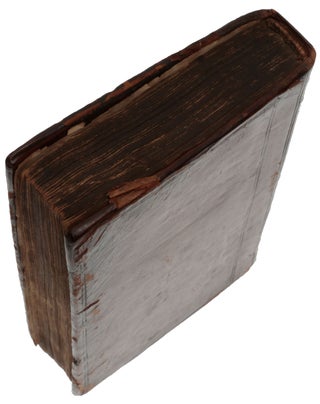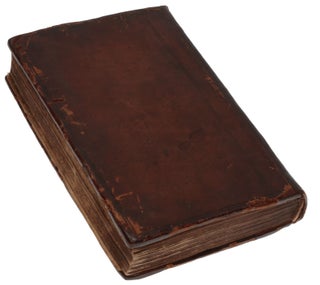De rachitide sive morbo puerili qui vulgo the rickets dicitur...
London: William du Gard for Laurence Sadler and Robert Beaumont, 1650. First edition, co-author’s copy, of the first full clinical description of rickets, then thought to have appeared only recently in England, and the first description of infantile scurvy. “In 1645 the Royal College of Physicians assigned to Glisson, Bate and Regemorter the task of writing a book on rickets – one of the earliest Instances of collaborative medical research in England. Six years later they published De rachitide, which, though not the first, was the fullest and most important account of rickets that had yet appeared [Daniel Whistler’s Leiden 1645 dissertation was the first description of rickets as a definite disease]. Glisson’s investigation of the essential nature of the disease so impressed his fellow workers that they allowed him to draft the entire book, which combined the observations of the three principal investigators with those of five other contributors. Glisson’s account of rickets, his first major publication, occupies chapters 3-14; aside from the clinical material and post-mortem observations on rickets, he deals with such subjects as circulatory regulation, mechanisms of nervous function and the nature of hereditary disease. He denied that rickets was caused by either syphilis or scurvy, and gave the first published description of infantile scurvy” (Norman). “Glisson emphasised the importance of morbid anatomy in the study of this disease and, indeed, described his post mortem findings before giving a description of the clinical signs and course of the disease. He was the first to appreciate that infantile scurvy was a separate entity, although it might coexist with rickets, whereas the profession generally considered them to be one disease until Barlow’s paper was published 200 years later. Glisson recognised, too, that rickets were neither congenital nor inherited, were not contagious, nor caused by syphilis. The nearest he came to a nutritional cause was to blame excessive feeding with its resulting indigestion, adding: ‘and perhaps this may be reputed among the especial causes why this disease doth more frequently invade the cradles of the rich than afflict poor men’s children’ … The discovery of this new disease, rickets, in the middle of the 17th century was probably due to the increasing urbanisation taking place at the time, as well as to misguided practices in infant feeding” (Dunn). The list of contributors on A5v includes the three main authors as well as the physicians R. Wright, T. Sheafe, N. Paget, J. Goddard, and E. Trench, making it “hard to tell how much of the classic anatomical and clinical descriptions of the disease belongs to Glisson alone. He claimed originality specifically for chapters 3-14. These are concerned mainly with the nature of the disease, which he believed to be a cold and humid distemper” (DSB). Like Glisson’s other works, this one is presented in an archaic, scholastic framework of reasoning. Harvey’s new theory is incorporated in the work “as a matter of course” (DSB) in a chapter on regulation of the circulation of the blood. ABPC/RBH list five other copies in the last half-century. Provenance: Ahasuerus Regemorter (1614-50), with his signature on p. 416, holograph corrections throughout (following the printed errata list), and a prescription in his hand at the foot of p. 377; Later signature of James Peiree on recto of front paste-down (detached from board); King's College [Columbia University] Medical School (ink stamp on p. 100); Purchased from H. P. Kraus; Haskell F. Norman (bookplate). “It is exactly three hundred years since Francis Glisson (1597?-1677) published the monograph on rickets which is justly regarded as one of the glories of English medicine. He was the son of William Glisson and was born at Rampisham in Dorset in 1597. He entered Caius College, Cambridge, in 1617, graduated B.A., later proceeded M.A., and became fellow and lecturer in Greek of his college. In 1627 he was incorporated M.A. at Oxford and soon afterwards, at the age of thirty, began the study of medicine. This was a time when interest was beginning to be diverted from the subtleties of metaphysics to physics and scientific method. In 1628 Harvey published his great revolutionary treatise Exercitatio anatomica de motu cordis et sanguinis, and declared that wise men must learn anatomy, not from the decrees of philosophers, but from the fabric of nature herself. Glisson graduated M.D. at Cambridge in 1634, was elected Fellow of the Royal College of Physicians the following year, and in 1636 was appointed Regius Professor of Physic at Cambridge. At the College of Physicians he lectured on anatomy, which included human, comparative and morbid anatomy. In 1640 he delivered the Goulstonian Lecture. In 1642 the great Civil War broke out; Oliver Cromwell defended Cambridge for the Parliamentarians but he was well disposed towards the University, having represented Cambridge in the Long Parliament and having been an undergraduate at Sidney Sussex College. Glisson left Cambridge soon after the outbreak of hostilities, but this could hardly have been due to military interference with his work; he was, moreover, a Presbyterian. He moved to Colchester where he built up a large private practice from a house in the parish of St Mary at the Walls. In the second Civil War the town was held by the Royalists, and in 1648 was besieged by Fairfax. Fifty-three houses were destroyed in the very parish where Glisson resided, and it was he who was chosen to be sent out to seek favourable terms of peace. He failed to obtain any concession even after two interviews with Lord Fairfax, and the defenders thereupon held out until forced to surrender through threat of starvation. After the siege Glisson left Colchester and settled in London. During previous visits he had lodged in a house in Fleet Street but ultimately took a lease of a house in New Street, Shoe Lane, in the parish of St Bride. Here he remained for the rest of his life. “In 1650 Glisson’s treatise on rickets was published in London with the imprimatur of the Censors of the College of Physicians. He had patiently worked on the disease for over five years before publishing the result of his investigations under the title Tractatus de Rachitide sive Morbo Puerile qui vulgo THE RICKETS dicitur. The treatise was the outcome of discussion amongst seven other Fellows of the Royal College of Physicians who knew of Glisson’s researches upon the malady. The preparation of the work for publication was eventually committed to the care of three of them, namely, Francis Glisson, George Bate and Ahasuerus Regemorter. Each was to contribute a part, but as the project proceeded it was found that Glisson had made such complete investigations and had written so much more than his companions that by common consent the task was left in his hands, Bate and Regemorter aiding by observation and criticism. Glisson’s original description of the external appearance of a rickety child is remarkably complete: the large head, the flabby muscles, the enlargements at the ends of the long bones, the beads on the ribs, the pigeon breast and the protuberant abdomen, all are carefully recorded. Hardly a symptom of the malady escaped him; he even mentions the association with scurvy, later described by Sir Thomas Barlow. And he declared that ‘this disease in its own nature is not fatal’; he was, however, able to carry out many dissections on children afflicted with rickets who had died from other causes. The following are some of his observations on the morbid anatomy of the disease: 1. An irregular or unusual proportion of the parts. The head is evidently larger than normal, and the face fatter in respect to the other parts. “He also described the enlarged liver and the changes in the mesenteric glands, but the thymus he knew to be large in childhood and was not misled by it. “In the medical treatment of the disease he followed tradition and the practice of his age, discussing humors and spirits at length and indulging in an extensive pharmacopoeia which embraced the most fanciful medicaments. Before Pasteur and Hopkins the physician was as much baffled concerning the cause and cure of many of the ills of mankind as was the surgeon before Lister in the treatment of an open wound inflicted by accident or by his own hand. When Glisson is not in bondage to Galen or to traditional theories of disease, and is free to express himself at will, his ideas become distinctly more modern in colour. After studying the surgical pathology of rickets he concluded that the disease was due to disturbed nutrition by arterial blood, and he believed the changes in long bones to be due to excessive vascularity. Most of the deformities of rickets Glisson attributed to unequal growth, and, unwilling to believe that rachitic bone was more flexible than normal bone, he failed to appreciate the deforming influence of body weight, posture and contracting muscle. Thus, of rachitic scoliosis he wrote: ‘We compare the bones therefore in which this crookedness useth to happen to a Pillar and not unaptly … but if you build the pillar of more stones and betwixt every two as has been said, a wedge be interposed on one side, it will not resemble a Pillar but the proportion of a Bow’ (Philip Arnim’s translation). And of knock-knee and bow knee he says: ‘This bending seemeth to be not unfitly referred to the inequality of nutrition. For if it happen by unequal nutrition, that one side of the Shank-Bone be so lengthened more than the other: Suppose outwardly, that it doth somewhat lift up the outward part of the epiphysis of the Shank-Bone (Tibia in original Latin) above the inward part, the joynt at the knee must needs stand outwardly bent; and on the contrary, if the inward part be lifted up, and the outward depressed, the same joynt must needs stand inwardly bent’ … “In the surgical treatment of knock-knee he used broad padded splints of thin iron which extended along the lower limb. For children with spinal curvature he devised a sling whereby they were suspended from the head and shoulders. In bed at night, pillows were placed under the prominence to help in correcting the rotation of the vertebrae. Because he believed that the malady was due to disturbed nutrition he favoured friction, or what to-day would be called massage: ‘But it is certain that rubbing doth powerfully summon the nutritive juice of the Bloody mass into the part so rubbed, therefore if at any time you rub that hollow part which is insufficiently nourished it is no wonder if it do good, being that thereby the aliment is more plentifully allured.’ “When Glisson began investigating rickets he shared with others the belief that the disease had but lately appeared in England and particularly in its southern counties. The word rickets first appeared in a Bill of Mortality of 1634 and is derived from the old English word wrickken, to twist. The word used in the expression ‘to wrick the neck,’ has the same derivation. Glisson suggested a technical term rachitis, from the Greek ρακις, the spine (one of the first parts affected), and because of its similarity of sound to the native word. The Tractatus de Rachitide passed through several editions, one of which was published in Leyden; the English translation by Philip Arnim appeared in 1651. In France and Germany the malady became known as ‘the English Disease.’ Five years before Glisson published his comprehensive account of rickets a brief and less well-informed account of the disease was presented at Leyden as a graduation thesis by Daniel Whistler, a probationary Fellow of Merton College, Oxford, who went to Leyden in 1642 to study medicine. In 1645 Whistler published a thesis entitled Morbo puerili Anglorum, quem patrio idiomate indigenae vocant The Rickets. He makes no claim to originality in his essay. Some vagueness here and there in the essay, together with meagre observations on morbid anatomy, suggests a limited knowledge of the malady. It is likely that Whistler was informed of the discussions on rickets proceeding amongst the Fellows of the College of Physicians, and in this thesis he even alludes to the views of one especially learned man. It is probable that he intended no more by his thesis than to give a preliminary account of an interesting piece of work proceeding in England. The complete description and elucidation of the disease of rickets, worked out in full clinical and pathological detail and bearing the impress of originality throughout, is that contained in Glisson’s Tractatus de Rachitide. But the earliest recognition of rickets was made by Soranus of Ephesus in his work on diseases of women; he, however, had given it no name. Soranus lived sometime at Alexandria, where he probably studied Greek medicine. He practised in Rome during the second century of our era, and his fame as a physician continued long after his day, for he was praised by both Tertullian and Augustine. “In the Tractatus de Rachitide, Glisson describes a way of treating spinal curvature by suspending the child: ‘The artificial suspension of the body is performed by the help of an instrument cunningly made with swathing bands, first crossing the breast and coming under the arm-pits, then above the head and under the chin, and then receiving the hands by two handles, so that it is a pleasure to see the child hanging pendulous in the air, and moved to and fro by the spectators. This kind of exercise is thought to be many ways conducible in this effect, for it helpeth to restore the crooked bones, to erect the bended joynts, and to lengthen the short stature of the body. Moreover, it exciteth the vital heat and withal aliureth a plentiful distribution of the nourishment to the external and first affected parts: and in the meantime it is rather a pleasure than a trouble to the child.’ “‘Glisson’s sling’ became well-known on the Continent and was in frequent use at the Royal National Orthopaedic Hospital until the early years of this century; it was replaced by Fisher’s suspension frame, which embodied the essential principle of the sling with less discomfort to the patient. In his Anatornia Hepatis, published in 1654, Glisson gave a full account of the normal and morbid anatomy of the liver. He described the areolar tissue which surrounds the portal vein, hepatic artery and hepatic duct at the transverse fissure of the liver and its prolongation into the substance of the organ as an enveloping sheath of the branches of these structures. This sheath became known as ‘Glisson’s capsule,’ a term familiar to every medical student. “In 1672 he published a philosophical treatise, Tractatus de Natura Substantiae energetica, which contained an anticipation of the theory of muscular contraction. In 1677 he published his last work, Tractatus de Ventriculo et Intestinis, a long anatomical treatise based on some of his lectures. It is dedicated in touching language to the University of Cambridge and the College of Physicians. All his books were reprinted several times. Twelve volumes of his manuscripts, including letters, prefaces and lectures, are preserved in the Sloane Collection at the British Museum. “Glisson, to his credit, stayed in London during the Great Plague of 1665, while some of his colleagues fled with their more favoured patients. He took an active part in the affairs of the College of Physicians and was elected Censor in 1656, Harveian Orator in 1659 and President for the three years 1667-69. He was also one of those ‘divers worthy persons inquisitive into natural philosophy and other parts of human learning,’ who in 1645 initiated a weekly meeting in London to promote research in natural science. Out of this nucleus of learned men the Royal Society was formed in 1660, with Glisson as an original member. He died on October 14, 1677, eighty-one years old, at his house in New Street, and was buried in St Bride’s, Fleet Street. “The Traclatus de Rachilide of over four hundred pages was the first monograph to appear in England dealing thoroughly with a single disease. It has aroused the admiration of all writers on diseases of children; in the words of Sir William Osler, ‘the entire monograph is an enduring monument to the skill and powers of observation of this great physician’” (Jones).
2. The external members and muscles of the whole body are seen to be delicate and emaciated, as though consumed by atrophy or tabes, and this (so far as we know) is always observed in those dead of this affection.
3. The whole skin, both the true and the fleshy and fatty layers, is flaccid and rather pendulous, like a loose glove, so that you think it could hold much more flesh.
4. About the joints, especially in the wrists and ankles, there are certain protuberances which, if opened, are seen to arise, not in the fleshy or membranous parts, but in the ends of the bones themselves, especially in their epiphyses.
5. The joints, limbs, and habitus of all these external parts are less firm and rigid, less inflexible than in other dead bodies, and the neck scarcely becomes rigid, a frigore post mortem, or to a less extent than in other cadavers.
6. The chest externally is thin and much narrowed, especially beneath the scapulae, as though compressed from the sides, and the sternum accuminated like the keel of a ship or the breast of a fowl.
7. The ends of the ribs which join with the cartilages of the sternum are nodular, like the ends of the wrists and ankles.
8vo (168 x 110mm), pp. [xxxii], 416 (numerous errors in pagination), woodcut diagrams in text. Contemporary blind-ruled calf (rebacked), custom clam shell cloth box.
Item #5420
Price: $20,000.00

